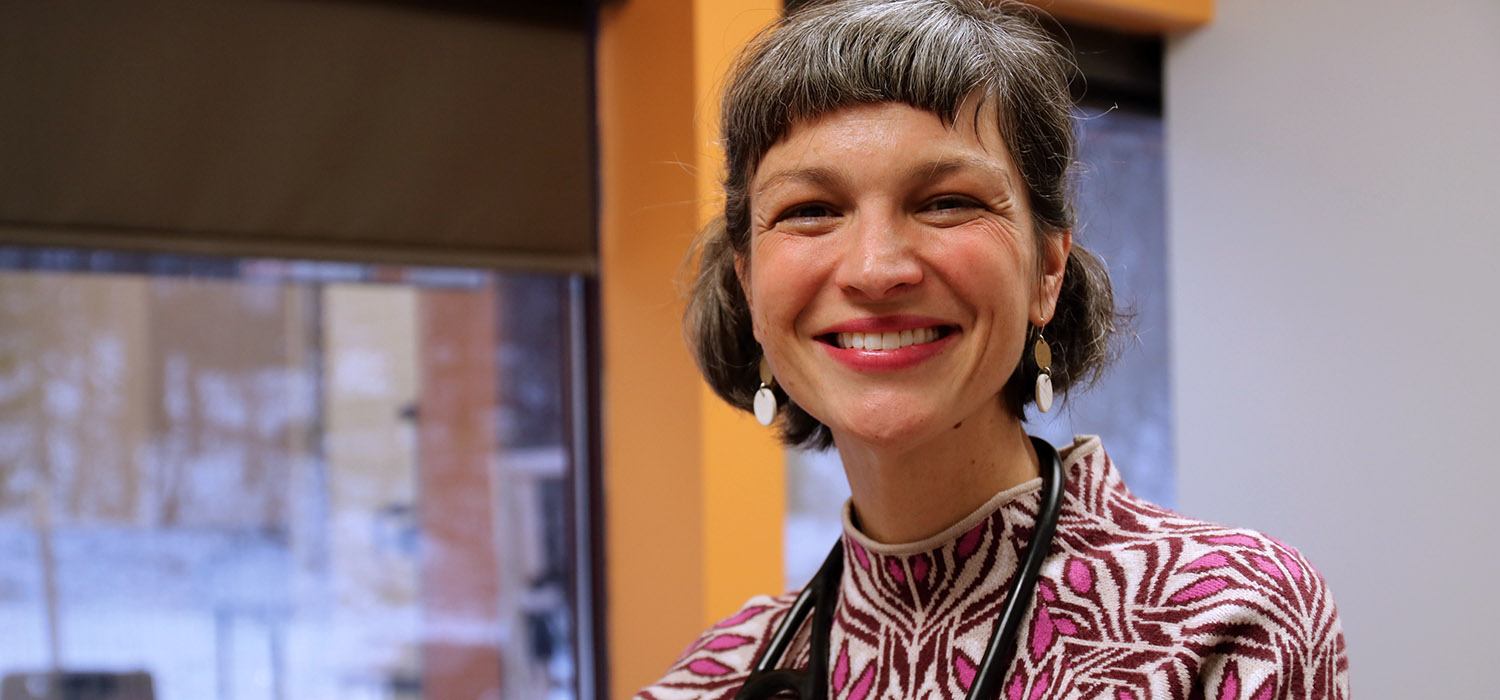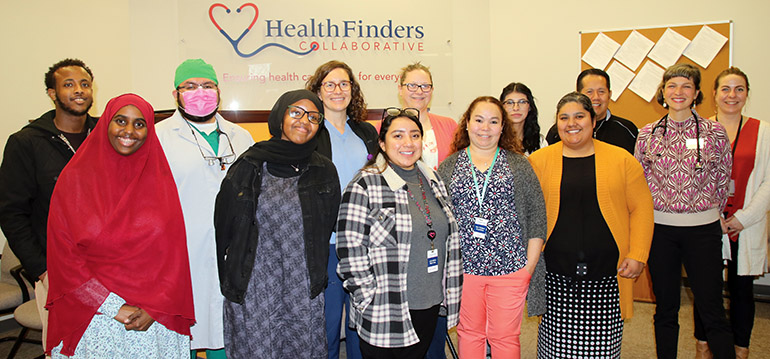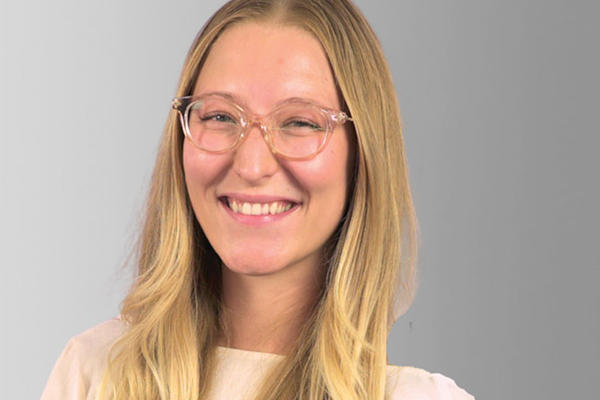The NP of sex and drugs
As a rural nurse practitioner, Emily Carroll, DNP ’20, shows where there’s a will, there’s a way
May 7, 2024
Brett Stursa

Emily Carroll led the launch of a Medication for Opioid Use Disorder clinic as a DNP student. Four years later, it continues to meet a need in the community.
It’s a Wednesday afternoon at the HealthFinders Collaborative in Faribault, Minnesota, which means the lead nurse practitioner Emily Carroll, DNP ‘20, APRN, CNP, will be seeing patients in the Medication for Opioid Use Disorder (MOUD) clinic.
For the last four years, the clinic has served patients seeking care for opioid addiction by providing buprenorphine, which lowers cravings and blocks the effects of opioids.
On this Wednesday afternoon in January, Carroll knows the patients she’s seeing well enough to ask about a recent vacation or upcoming dental work. While questions about cravings and dosages come up during each 30-minute appointment, most of the conversations center on other aspects of life — navigating Medicaid or how work at the assisted living facility is going.
“I love seeing a patient’s vacation photos, hearing about their families or jobs and just being a supportive listener to stories about the often interrupted path of recovery. What I am often doing is making a positive space to rebuild trust and bridges between patients and health care to make it easier for them to come back to their next appointment. If I can build that trust, patients may be more likely to talk about treatment for Hepatitis C or maybe cutting back on their methamphetamine use,” says Carroll.
After working as a primary care family nurse practitioner at HealthFinders for 10 years, Carroll returned to school and led the launch of the MOUD clinic as part of her scholarly project as a student in the post-master’s Doctor of Nursing Practice program at the University of Minnesota. Her leadership in establishing the clinic and her commitment to serving patients in Faribault recently earned her the Distinguished Humanitarian Award from the Nursing Alumni Society.
“She has undoubtedly saved countless lives, narrowed cultural disparities, expanded medical services among underinsured or uninsured patients in a rural setting, and contributed to educational efforts of the next generation,” wrote Connie Jaenicke, MSN, CNP, AOCNP, in the nomination letter.
The numbers show a need
Prior to establishing the MOUD clinic, Rice County had year-over-year increases of opiate-related fatalities and non-fatal overdoses. Situated about 50 miles south of Minneapolis, Rice County is a blend of agriculture and industry. Both Jennie-O Turkey and Faribault Foods are major employers in Faribault, which is the county seat and has a population of about 55,000.
While there was one doctor who traveled from Hennepin County twice a month to hold a MOUD clinic in Lonsdale, it could be hard to get an appointment. Other MOUD clinics were even farther away. The distance and lack of accessible transportation were significant barriers for rural patients seeking help. Many of them had lost their driving licenses, which are expensive to reinstate, making it difficult to seek care.
“The numbers showed a real need,” says Carroll. “And then, we were all hearing more and more local stories of how difficult it was to get access to buprenorphine.”
When the Rice County Mobile Opiate Support Team received funding to expand access to opiate use disorder treatment, it supported the launch of the MOUD clinic at HealthFinders Collaborative and, later, at the Rice County Jail. “It’s really unusual that we’re able to work with the rural county jail to see patients,” says Carroll.
Since then, Carroll mentored local physicians and nurse practitioners in MOUD care and provided harm reduction and stigma-decreasing education to law enforcement members in Rice County, including three police departments and the Sheriff’s Office.
HealthFinders and the Rice County Mobile Opioid Support Team also obtained funding to ensure all of the MOUD patients have access to group therapy, inpatient/outpatient treatment, and assistance with obtaining health insurance, paying for medication and housing.
Carroll, who graduated in 2020, says launching the MOUD clinic as her scholarly project brought depth and substance to the initiative. It also provided the structure that led to publishing an article, Implementation of office-based buprenorphine treatment for opioid use disorder, about the launch in the Journal of the American Academy of Nurse Practitioners.
“By publishing, I was able to disseminate our work and hopefully show people this can be done with a lot of will and very few resources. You can do this and, in fact, you should do it,” says Carroll.
Evolving services to meet community needs
As a community clinic, HealthFinders relies on a combination of grants, fundraising and volunteers to provide primary care, dental care and mental health care to people with limited access to health care. The clinic started in a church basement in Dundas, Minnesota, between Northfield and Faribault, in response to the lack of health care access that undocumented people were experiencing.

As needs in the community have evolved, so have services. The clinic now has a syringe exchange — a particular point of pride for Carroll — and is officially an outpatient treatment program. “That means if somebody is court ordered to go to treatment, they could receive it here in Faribault at HealthFinders, which is important because we’re the only ones that have bilingual, bicultural, Somali- and Spanish-speaking folks. There’s no other place in Rice County with that. You'd have to go up to the cities,” says Carroll, noting they were able to expand while many other treatment programs are closing.
In addition to seeing patients in the MOUD clinic, Carroll sees patients for primary care and has developed a reputation of being the “NP of sex and drugs.” “I do a lot of adolescent health care. There is a lot of overlap in chemical health and sexual health,” says Carroll, who provides sex education at the Faribault High School through a Minnesota Department of Health grant for teen pregnancy prevention.
She balances her time at HealthFinders with her positon as an assistant professor in nursing at St. Olaf College. In addition she serves on several boards, including Rice County Mobile Opioid Support Team and Rice County Community and Justice Council. She is the first nurse on the Community and Justice Council, which historically had a physician representing health care.
“Caring for patients with substance use is such a good fit for the nursing role, and I’m so glad to be able to amplify that,” says Carroll. “Nurses should be at the table of health and social service-related organizations.”
Figuring it out together
Collaboration and transparency are key to making initiatives like the MOUD clinic work, says Carroll. “I think we try not to surprise anybody with our work here. We’re completely transparent at every step, making sure the schools know what we’re doing, the police know what we're doing, social services. Because we’re so reliant on working with other people, we’ve built a lot of trust and built community as well.”
Those partnerships go hand-in-hand with being a rural health care provider immersed in her adopted home town. “It can be so helpful and inspiring to just fix it together as a community, trying to figure it out together,” says Carroll.


